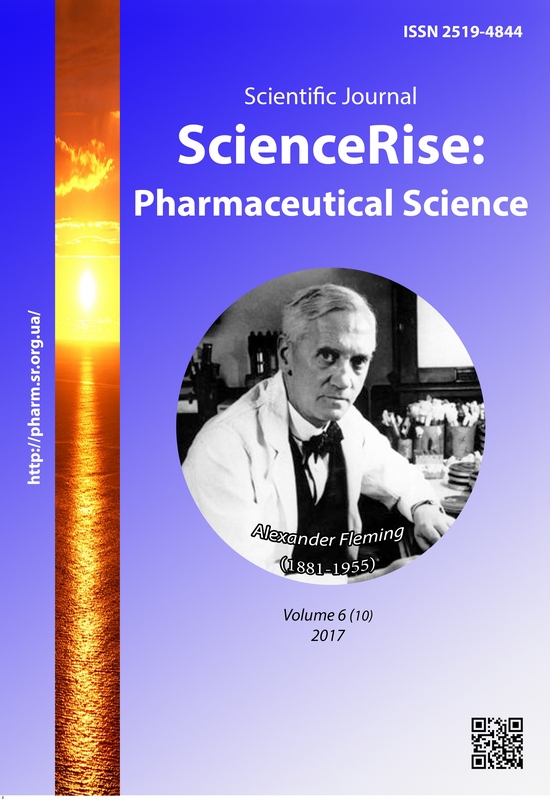Substantiation of the composition of surface-active substances in development of a cream with silver citrate
DOI:
https://doi.org/10.15587/2519-4852.2017.119890Keywords:
emulsion system, surfactants, cream, silver citrate, stabilityAbstract
Pharmaceutical emulsions are now given increasing attention because they are widely used in medical practice. This became possible due to a qualitatively new level of scientific research and achievements in the field of emulsion systems creation, as well as expansion of assortment of auxiliary substances and use of new modern equipment. Emulsions are heterogeneous disperse systems that are potentially unstable. Therefore, the issue of stabilizing of emulsion systems is the main problem in area of emulsions technology.
Aim. The aim of the experiment was to study structural and mechanical properties of concentrated emulsion systems, depending on the total concentration of surfactants, as well as investigation of colloidal and thermal stability of samples for substantiation of the composition of surfactants in the development of a cream with silver citrate.
Methods. Pharmaco-technological methods of research were conducted in accordance with the requirements of the State Pharmacopoeia of Ukraine.
Research results. Colloidal and thermal stability of the samples of emulsion cream with silver citrate was investigated. It has been established that the use of emulsifiers in concentrations of 4 % and 6 % does not provide physical stability. A dispersion analysis of the heterogeneous systems was carried out, which has shown that the samples obtained by using of the emulsifiers combination are homogeneous in size of particles of oil phase, which do not exceed 10 microns. The behavior of samples of the emulsion cream with silver citrate during and after mechanical destruction is investigated. The results guarantee stability of the system under the influence of mechanical processing during industrial production and use.
Conclusion. As a result of the experiment, the use of the combination of surface-active substances: emulsifier № 1 and cetostearyl alcohol of 8-10 % was used to stabilize the emulsion system with silver citrate
References
- Vasconcelos, T., Marques, S., Sarmento, B. (2017). Measuring the emulsification dynamics and stability of self-emulsifying drug delivery systems. European Journal of Pharmaceutics and Biopharmaceutics, 123, 1–8. doi: 10.1016/j.ejpb.2017.11.003
- Zafeiri, I., Smith, P., Norton, I. T., Spyropoulos, F. (2017). Fabrication, characterisation and stability of oil-in-water emulsions stabilised by solid lipid particles: the role of particle characteristics and emulsion microstructure upon Pickering functionality. Food & Function, 8 (7), 2583–2591. doi: 10.1039/c7fo00559h
- Chuieshov, V. I., Gladukh, I. V., Saiko, I. V. et. al. (2013). Technology of medicines for industrial production. Kharkiv: NFaU: Oryhinal, 638.
- Kutts, G., Friss, S., Khenning, S. et. al. (2004). Cosmetic creams and emulsions: Composition. Receiving. Test methods. Moscow: Klavel, 272.
- Sakamoto, K., Lochhead, R., Maibach, H., Yamashita, Y. (Eds.) (2017). Cosmetic science and technology: Theoretical principles and applications. Amsterdam: Elsevier, 854.
- Pletnev, M. Yu. (2002). Surface-active substances and compositions. Moscow: "Firma Klavel", 768.
- Walters, Y., Roberts, M. (Eds.) (2007). Dermatologic, cosmeceutic and cosmetic development. Boca Raton: CRC Press, 648. doi: 10.3109/9780849375903
- Cheng, Q., Zhang, B., He, Y., Lu, Q., Kaplan, D. L. (2017). Silk nanofibers as robust and versatile emulsifiers. ACS Applied Materials & Interfaces, 9 (41), 35693–35700. doi: 10.1021/acsami.7b13460
- Yang, Y., Fang, Z., Chen, X., Zhang, W., Xie, Y., Chen, Y. et. al. (2017). An Overview of Pickering Emulsions: Solid-Particle Materials, Classification, Morphology, and Applications. Frontiers in Pharmacology, 8. doi: 10.3389/fphar.2017.00287
- Tadros, Т. (2006). Principles of emulsion stabilization with special reference to polymeric surfactants. Journal of Cosmetic Science, 57, 153–169.
- Aidarova, S., Sharipova, A., Kragel, J., Miller, R. (2014). Polyelectrolyte/surfactant mixtures in the bulk and at water/oil interfaces. Advances in Colloid and Interface Science, 205, 87–93. doi: 10.1016/j.cis.2013.10.007
- Pertsev, I. M., Dmytriievskyi, D. I., Rybachuk, V. D. et. al.; Pertsev, I. M. (Ed.) (2010). Dopomizhni rechovyny v tekhnolohii likiv: vplyv na tekhnolohichni, spozhyvchi, ekonomichni kharakterystyky i terapevtychnu aktyvnist [Excipients in drugs technology: influence on technological, consumer, economic characteristics and therapeutic activity]. Kharkiv: Gold pages, 600.
- Kukhtenko, H., Gladukh, I., Kukhtenko, O., Soldatov, D. (2017). Influence of excipients on the structural and mechanical properties of semisolid dosage forms. Asian Journal of Pharmaceutics, 11 (3), 575–578. doi: 10.22377/ajp.v11i03.1462
- Polova, Zh. N. (2017). Justification of the composition of the cream of antimicrobial action on the basis of rheological studies. Republican scientific journal "VESTNIK" of the South Kazakhstan State Pharmaceutical Academy, 1 (78), 140–144.
- Polova, Zh. N. (2017). Determination of the stability of veterinary cream containing silver citrate. ScienceRise: Pharmaceutical Science, 4 (8), 21–26. doi: 10.15587/2519-4852.2017.108947
- Estanqueiro, M., Amaral, M. H., Sousa Lobo, J. M. (2016). Comparison between sensory and instrumental characterization of topical formulations: impact of thickening agents. International Journal of Cosmetic Science, 38 (4), 389–398. doi: 10.1111/ics.12302
- Calixto, L. S., Maia Campos, P. M. B. G. (2017). Physical-Mechanical characterization of cosmetic formulations and correlation between instrumental measurements and sensorial properties. International Journal of Cosmetic Science, 39 (5), 527–534. doi: 10.1111/ics.12406
Downloads
Published
How to Cite
Issue
Section
License
Copyright (c) 2018 Zhanna Polova, Ievgenii Gladukh, Halyna Kukhtenko

This work is licensed under a Creative Commons Attribution 4.0 International License.
Our journal abides by the Creative Commons CC BY copyright rights and permissions for open access journals.








